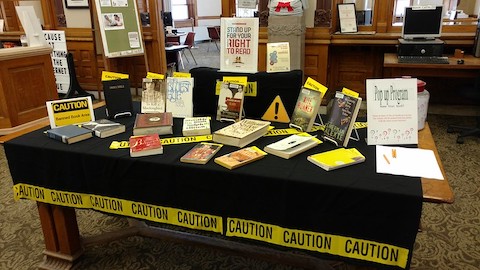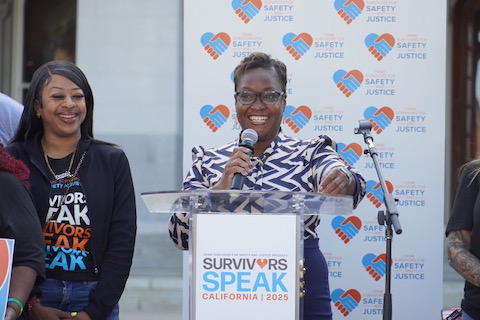
18 Feb Banning Books in Prison: State Website Lists Titles Considered Inappropriate for Inmates

A library celebrates Banned Books Week in 2016. “The Kite Runner” and “Fifty Shades of Grey” are both titles on this table and on the CDCR list of disapproved publications. (“Banned Books Week 2016” by Charles Hackley / Hackley Public Library via Flickr / CC BY 2.0 license)
By Steve Brooks
Bay City News
A new state law requires California to maintain oversight of all publications banned in state prisons.
The state’s Office of the Inspector General under Assembly Bill 1986 must now post the Centralized List of Disapproved Publications of books, magazines, newspapers, or other publications disapproved by the California Department of Corrections and Rehabilitation on a website.
“AB 1986 is designed to bring accountability and increased transparency to CDCR’s book banning process,” said Assemblymember Isaac Bryan, D-Los Angeles, who authored the bill that changed the law. “It’s time to stop banning books that help people transform their lives.”
CDCR has disapproved over 1,600 books. A federal appeals court ruling has found that publishers have a First Amendment right to communicate with prisoners by mail and prisoners have a First Amendment right to receive it.
However, CDCR prohibits any publication it considers to be contraband. Books and magazines are considered contraband if they’re sexually graphic, contain frontal nudity, or contain matters that tend to promote gangs, incite murder, arson, riot, violent racism, or any other act of violence.
Ethnic authors more likely off limits
“I had a copy of ‘The Anarchist Cookbook‘ in my cell in 1992, before officers took it,” said Damone Ray Clark, who has been incarcerated for almost 40 years. “I understand why they took it, but I wasn’t going to do none of the stuff in it,” he said.
>>>Read: Playing Solitaire: What I Learned in Five Months in Jail<<<
The list of disapproved books include such titles as: “Game of Thrones,” “The Kite Runner,” “The Handmaid’s Tale” and “Lady Gaga – Born to be Free.” But most books that are banned seem to be disproportionately written by Black and Latino authors and activists, according to Bryan.
Some of these books include: “2pac vs. Biggie: An Illustrated History of Rap’s Greatest Battle,” “A Child of A Crackhead,” and “Black Against Empire: The History and Politics of the Black Panther Party.”
Prison officials say racial books disrupt social order and contribute to an unsafe prison environment. But Bryan points out: “In California prisons you can read ‘Mein Kampf’ by Hitler, but you can’t read ‘A Prisoner In the Garden’ by Nelson Mandela,” he said.
This is not just in California. In 2009, former President Barack Obama’s books “Dreams of My Father” and “The Audacity of Hope” were banned at a Colorado supermax prison facility until there was a public outcry. In 2020, Bryan Stevenson’s book “Just Mercy” was banned in prisons in Kansas and North Carolina.
Under this new law, any incarcerated person, publisher, or other affected person may request that the OIG review any publication on the list to determine if the office concurs with CDCR’s determination that the publication violates policy. If the OIG doesn’t agree, it will notify CDCR.
CDCR’s centralized list must include at a minimum the title, the author, the publisher, year of publication and stated violation of CDCR policy that caused the publication to be prohibited. The OIG shall report annually to the governor and Legislature a summary of its reports and it must be available for public view. Each publication that is reviewed must be summarized and each disagreement OIG has with CDCR must be posted.
Public libraries also affected
Even California public libraries will be subject to closer scrutiny when it comes to banning books under a new Freedom to Read law. Assembly Bill 1825, authored by Assemblymember Al Muratsuchi, D-Torrance, will prohibit banning books based on race, nationality, religion, gender identity, and sexual orientation.
At least 30 states heavily disapprove of books by Black authors, including classics like Alice Walker’s “The Color Purple” and “The Autobiography of Malcolm X.”
More recently, a book titled “Tip of the Spear: Black Radicalism, Prison Repression, and the Long Attica Revolt” by Orisanmi Burton was banned in several states, including California and New York.
In an open letter last year, Burton wrote, “I reject the notion that my book ‘advocates … lawlessness, violence, anarchy, or rebellion against governmental authority,’ or that it ‘incites disobedience,’ as was claimed in a memo from New York prison officials.”
He wrote, “A close reading of Tip of the Spear will reveal that it advocates only that people think in radically different ways about the historical role of prisons in U.S. Society.”
Undoubtedly, Burton’s book will be among many tested by the new transparency law.
“It doesn’t make sense to me that educational and historical books are being banned in prison,” said Clark. “Education is supposed to be important to the process of rehabilitation.”
Steve Brooks is a California Local News Fellow with Bay City News Foundation, reporting from inside San Quentin Rehabilitation Center. His perspective gives readers insight into issues and news from inside the prison. See more of his work at Inside/Out on Local News Matters.
This story was first published on LocalNewsMatters.org, an affiliated nonprofit site supported by Bay City News Foundation.
Copyright © 2025 Bay City News, Inc. All rights reserved. Republication, rebroadcast or redistribution without the express written consent of Bay City News, Inc. is prohibited. Bay City News is a 24/7 news service covering the greater Bay Area.






No Comments